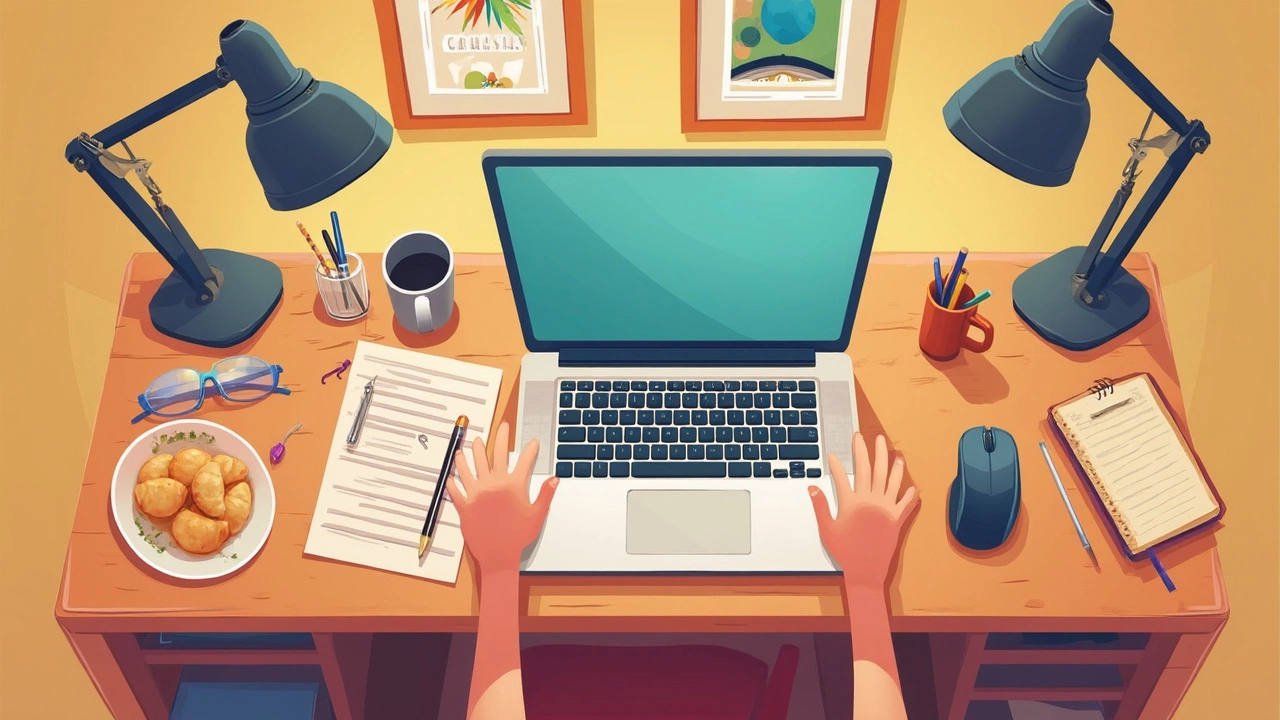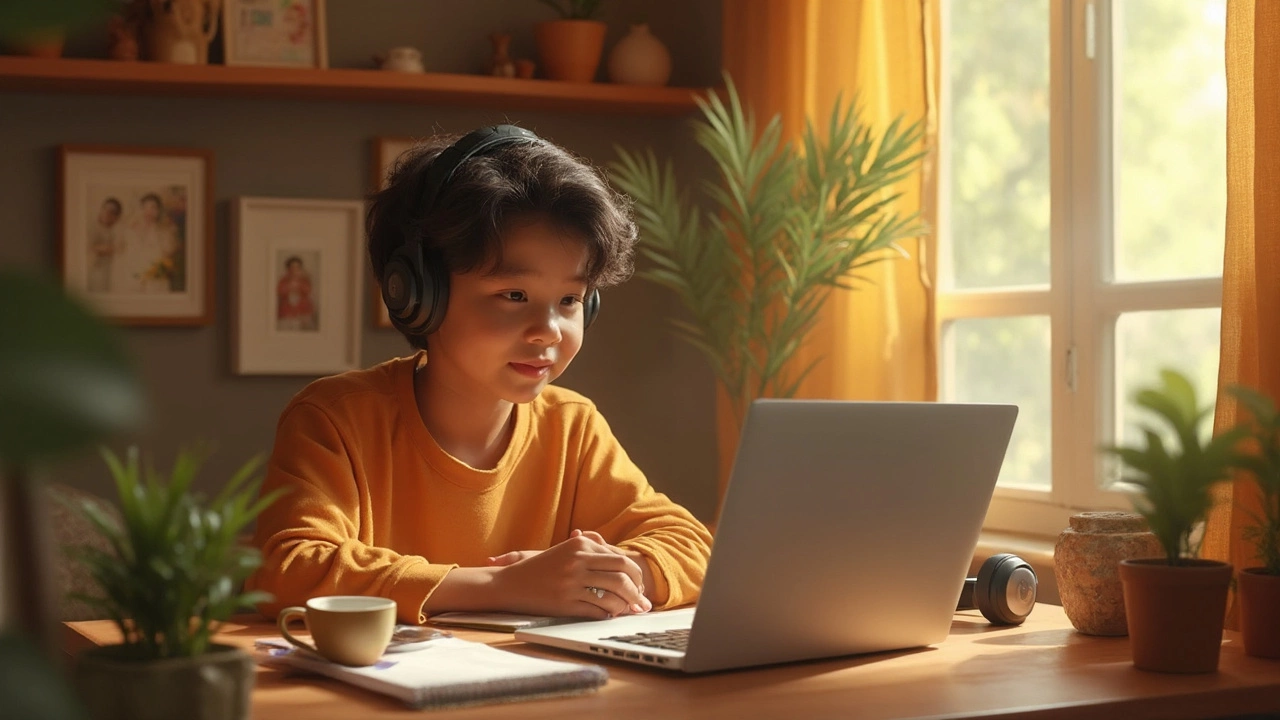Most people think a learning station means just grabbing your laptop and plopping down at the kitchen table. It does the job—sort of—but you’ll notice pretty fast that things get chaotic: noisy distractions, missing chargers, no structure. If you want e-learning to actually work, there’s a smarter way to set up your space.
First up, location really matters. If you can, find a spot that you only use when you’re learning or working online. Doesn’t have to be a fancy office or huge desk—sometimes a corner with a comfy chair and a small table is enough. The trick is making that spot off-limits for other stuff like eating, gaming, or folding laundry. This helps train your brain that this area equals 'work mode.'
- Finding the Perfect Spot
- Choosing the Right Tech and Gear
- Personalizing Your Space
- Boosting Focus and Motivation
Finding the Perfect Spot
Nailing down the right place for your learning station isn't just about comfort; it's about setting yourself up for fewer distractions and better results with any e-learning platform. Step one: steer clear of high-traffic zones. Spots like the kitchen or living room might seem easy, but you'll end up getting interrupted every ten minutes. Bedrooms can work if you don’t start dozing off, but be honest about your habits.
Your spot doesn’t need to be fancy. What matters is consistency—use the same corner, table, or desk each session. This sets a mental routine, so your brain switches into 'study mode' on autopilot. Lighting can make or break your vibe. Daylight is best if you can get it, but a decent desk lamp works wonders. Studies show that good lighting cuts down on eye strain and keeps people 16% more focused, especially for digital tasks.
Think about what’s behind you, too. If you’re ever on video calls or group sessions, you probably don’t want your laundry pile in full view. A plain wall or bookshelf is enough to keep things tidy in the background. Here’s a quick checklist to double-check your spot:
- Low noise or distractions (away from the TV and doorways)
- Enough room for your laptop, notepads, and a drink
- Power outlets within reach for charging devices
- Stable internet connection—Wi-Fi boosters help if your signal cuts out
- Comfortable chair you won’t hate after an hour
Still not sure? Plenty of learners use headphones or white noise apps to block out background sounds, especially in small apartments or shared houses. No matter where you pick, the main thing is to make that online study space your own, even if it’s just a tiny nook by a window. Small tweaks make a huge difference once you settle in for remote learning.
Choosing the Right Tech and Gear
If your learning station isn’t loaded with the right stuff, it’s going to slow you down. Start with the basics: a reliable laptop or desktop. For most e-learning platforms, anything made in the last five years with at least 8GB RAM, a decent webcam, and up-to-date software will work fine. Chromebooks do the trick if you’re mainly using browser-based tools, but double-check that they run your learning apps—some older models don’t play nice with video calls or PDF editors.
Next, internet. If you’re watching live lessons or streaming content, you’ll want at least 25 Mbps download speed per person in your home. Buffering or dropped calls can totally wreck your flow. Consider a wired connection or a mesh Wi-Fi system if your space is far from the router. Here’s a quick table to size up what speeds different activities chew through:
| Activity | Recommended Speed |
|---|---|
| Video Lectures (HD) | 5 Mbps |
| Video Lectures (4K) | 20 Mbps |
| Group Video Calls | 10 Mbps |
| Online Quizzes/Docs | 2 Mbps |
Now, think through your accessories. A solid pair of headphones (bonus if they’re noise-canceling) can kill distractions, especially if you’ve got roommates or family around. Get a mouse—even if you use a laptop—since it’s just faster for navigating most e-learning platforms. A separate keyboard and an external monitor also make marathon study days less painful for your back and eyes.
- A surge protector with USB ports means fewer cable tangles and all your gear stays powered up.
- Blue light glasses help if you get headaches from staring at screens for hours.
- Keep a simple notepad and pen handy for quick scribbles—sometimes old-school just works best.
Don’t go all-in on fancy equipment until you know what you’ll really use—try things out for a week before you buy upgrades. Ask classmates or friends what gear they actually rely on. The right mix of tech and gadgets turns your space into a hassle-free online study space instead of a tech nightmare.

Personalizing Your Space
Your learning station should fit your style and needs—otherwise, it just feels bland, and you'll look for any excuse to bail. Start simple: add stuff you actually like looking at. We're talking small things—a plant, a favorite mug, even a sticker or two on your laptop. The National Institutes of Health found that having a green plant at your desk can boost focus by 15% on average. That little boost matters when you start zoning out on long e-learning sessions.
Lighting is huge. Natural light beats harsh LEDs every time, so position your station near a window if you can. But if daylight isn’t an option, grab a warm adjustable desk lamp. Plenty of studies, including one from Cornell, show that poor lighting leads to more eye strain and headaches, which tank your productivity.
Now, let’s talk gear. Use your online study space to show off your personality, but don’t forget comfort. A chair that supports your back will make marathon learning sessions easier (your future self will thank you). I once borrowed a chair from the dining room until my lower back started complaining—swapping it for an ergonomic one made a huge difference.
- Use noise-canceling headphones if background sounds throw you off.
- Add a pinboard or whiteboard to track assignments and ideas. My partner, Clara, swears by sticky notes—her wall looks like a rainbow, but she never misses a deadline.
- Hide cords and cables with clips or Velcro straps. A tidy remote learning setup is way less stressful.
- Give yourself a charging station for all your devices, so you never run out of battery in the middle of an online test.
If you need a little tech inspiration, here's how some basics can help:
| Item | Benefit |
|---|---|
| Webcam cover | Easy privacy between classes |
| Laptop stand | Reduces neck pain from long sessions |
| Blue-light filter glasses | Helps reduce eye strain |
Your digital learning space should make you want to stick around and get things done. A few tweaks that match your tastes and habits can turn it from just a desk to a place where you actually enjoy tackling classwork.
Boosting Focus and Motivation
Even the best learning station won’t help if you can’t concentrate or stay motivated. But don’t sweat it—there are some smart, tested ways to keep your head in the game when you’re buried in online lessons or endless quizzes.
Start with a real schedule. Our brains love routine, and research from MIT shows habits are easier to stick to if they’re locked into specific times and spots. So, treat your study time like a meeting you can’t bail on. Set alarms, block out sessions on your phone, and let the people around you know when you’re "off limits."
Next, mix things up every time you hit a wall—try the Pomodoro technique if you’ve never heard of it. It’s simple: work for 25 minutes, then take a five-minute break. After four rounds, take a longer break. Apps like Focus Booster or even a kitchen timer works fine. This old trick actually helps you get more done (and makes the work feel less endless).
- Keep water and a healthy snack nearby. It sounds basic, but hydration and food actually wake up your brain. Science says mild dehydration can kill focus fast—so don’t skip the water bottle.
- Light matters. People who use good lighting during long hours on e-learning platforms report less eye strain and headaches. Natural light is ideal, but a cheap desk lamp with bright LED bulbs does the trick, too.
- Clear desk, clear mind. Clutter is proven to distract you, so try “desk zero”—everything off your surface except the exact stuff you need for the task.
On the motivation front, celebrate finishing things. I’m not saying throw a party after every math quiz, but check things off a list, blast your favorite song, or grab a snack break with no guilt. Small rewards make it easier to stick to your online study space routine.
| Focus Booster | Motivation Hack |
|---|---|
| Pomodoro technique (25 mins on, 5 off) | Finish tasks, then reward yourself (song, treat) |
| Set phone to "Do Not Disturb" while studying | Track progress on a visible checklist |
| Use noise-cancelling headphones for distractions | Join an online study group for accountability |
If you feel stuck after all this, swap your study spot for a session or two—relocate to another corner of the house, or even step outside if you can. Sometimes just seeing a different wall gives your brain a reboot. The right mix of structure, smart breaks, and a little self-reward keeps your remote learning setup running smoother—and way less boring.
